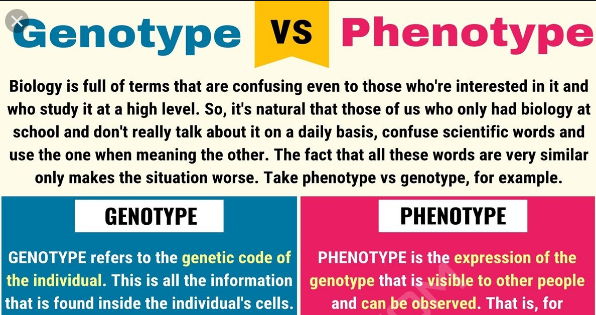What is Difference Between Genotype and phenotype?
The genotype is the genetic code of the cells of an organism, which determines the characteristics of an individual. The phenotype is the trait that we can observe, either as a physical characteristic or as a behavior.

The phenotype depends on the genotype, and additionally, it can be influenced by environmental and nutritional factors.
| Genotype | Phenotype | |
|---|---|---|
| Definition | Genetic composition of an individual determined by the DNA sequence. | The detectable manifestation of the genotype. Observable traits, such as hair color, bone size. |
| Etymology | From Greek genes = birth, and typos = brand: birthmarks. | From the Greek painting = show, and typos = brand: the marks shown. |
| Depends on | The hereditary information that was given to an individual by their parents. | Genotype
Environment The nutrition |
| Heritage | Hereditary transmitted from parents to their offspring. | Inheritance partially influences. |
| Contains | All hereditary information of an individual. | Observable features |
| Measurement | Biological tests and genetic sequencing. | Through the senses, such as vision or touch. |
| Examples | The sequence of recessive and dominant genes for blood groups. | The blood groups A, B, AB and O that are expressed in human red blood cells. |
Definition of genotype and phenotype
The genotype is constituted by the genetic composition of a cell. The genotype of an individual includes all genes that may or may not be expressed, that is, that produce a certain protein.
Most genes have at least two alternative forms, called alleles. When the alleles are equal, the individual is homozygous; When the alleles are different, the individual is heterozygous.
For example, in pea plants, the flower color gene has two alleles: the white allele and the purple allele. If the pea plant has two purple alleles it is homozygous; If the plant has a purple and a white allele, the plant is heterozygous.
The phenotype refers to a trait that can be observed as physical or behavioral characteristics. In the case of pea plants, the phenotype of a plant with two purple alleles will be purple flowers, the phenotype of a plant with two white alleles will be white flowers. In the case of plants with a purple allele and a white allele, the phenotype will be purple flowers, because the purple allele is dominant.
Genotype and phenotype identification
The genotype can be identified through several chemical tests that mainly consist in determining the genetic constitution of the individual. Among these tests we have DNA analysis tests, paternity tests and polymerase chain reaction (PCR), among others.
The phenotype can be identified by observing the characteristics of the individual. Sometimes these characteristics cannot be seen with the naked eye. For example, to determine the phenotype of the blood group of human red blood cells, a laboratory analysis is required.
Relationship between genotype and phenotype
The genotype of an individual comprises its entire genetic constitution. This includes dominant or recessive genes, regulatory sequences and what is known as junk DNA, which is DNA that is not yet known what it is for.
The phenotype is the result of genes that can be expressed and external factors that affect their expression: environmental, nutritional and chemical factors.
If we make the analogy of the genotype and the phenotype with a book, the genotype is the whole book: the leaves and what is written on them. The phenotype, on the other hand, is what we read in the book.
Genetic heritage
In organisms with sexual reproduction, sex cells or gametes have half the genetic load of the species. When a female gamete is combined with a male game, they complete the individual’s genetic load. Then, the genotype of this individual is the result of the combination of the genotypes of their procreators.
Although the phenotype is determined by genotype, and this by inheritance, there are other factors that affect phenotypic manifestations. For example, if a baby does not receive adequate nutrition during its first stage of life, it may not reach the height that was determined in its genes.
We also have the case of identical twins that have the same genotype but may have different phenotypes.
The phenotype of an individual may change during his life, depending on what genes are expressed and how external conditions affect them. For example, a young child with green eyes may have blue eyes after a while.
You May Also Interested:
